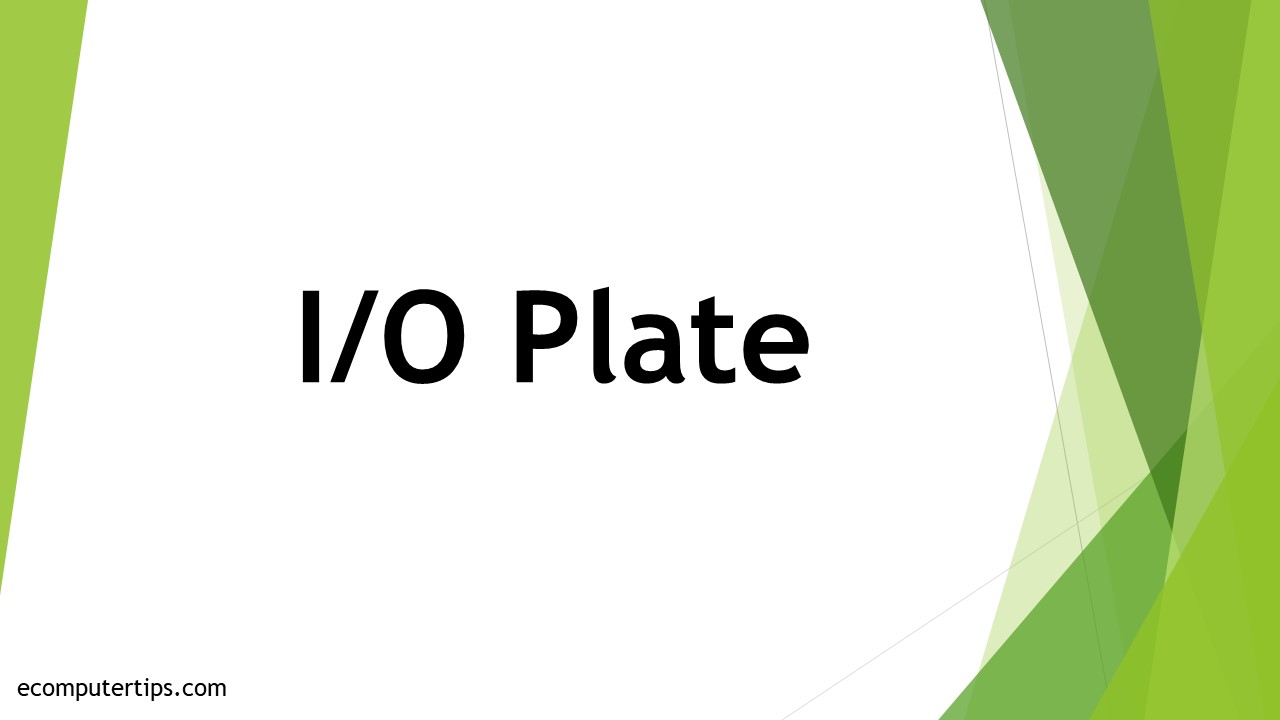In This Article
What is an I/O Plate?
The I/O plate is the thin plate at the back of the computer case. This removable plate is a protective shield with precise holes in it to allow access to the USB port, Ethernet port, HDMI port, and other connectors.
The I/O plate is a small sheet of metal with holes matching the ports on the motherboard punched in it. It is rectangular in shape and is used to cover the gaps left in the case for the rear I/O slots.
KEY TAKEAWAYS
- The I/O plate is the protective covering found at the back of the computer case.
- The plate is fixed between the motherboard and the computer case with screws at the edges.
- The holes on it match the ports or slots on the motherboard accessible on the rear panel.
- Though the plate is related to the motherboard and the computer case, it is not an integrated part of any of them.
- This plate covers the gaps that serve two primary purposes, such as preventing dust and other things from entering inside the computer case and making it look neater.
Understanding the I/O Plate

There is a wide and varied range of connectivity on the motherboards. Proper mounting of the board will allow easy access to these connectors through the different gaps found at the rear of the computer case.
Though the connectivity options may vary from one motherboard model to another, all of them will come with a custom piece of hardware. This is called the I/O plate.
This specific plate is the protective covering of the motherboard found at the back of the computer cabinet. Alternatively, this plate is also known by other names, such as:
- I/O template
- I/O shield
- I/O connector plate and
- Input/output plate.
There are one or more generic I/O templates in every new computer case. This removable plate has dual functions to perform, such as:
- To protect the innards of the computer and
- To allow easy access to the connectors and other slots.
However, these plates may be replaced by the one built into the motherboard, and all the necessary holes for the appropriate slots are punched in the plate.
On the other hand, this may not always be the case because some motherboards may not come with an I/O plate with pre-punched holes in it.
The number of holes punched in the plate may not always match the layout of the ports on the motherboard.
If you find one such plate while building your computer, you must make sure that you punch it out before installing.
This can be easily done with the help of a screwdriver.
Also confirm that the holes on the plate correspond to the back panel of the motherboard, and punch out those that match.
Most motherboard manufacturers usually print small labels or imprint a sign next to all or some of the ports for easy identification.
Usually, the input and output plates are made out of thin metal sheets cut with precision, but sometimes you may also find plates made out of silver plastic material.
Sometimes, these plates may also come with a thin layer of foam material in them, which can dampen vibrations and protect the innards of the computer case.

What is the Need for It?
The I/O plates are attached at the back of the computer case and have holes in them to allow access to the ports and slots on the motherboard. Apart from that, the plate also enhances the aesthetics of the computer by covering the gaps.
Ideally, the I/O shield does not have any direct effect on the performance of the motherboard or the computer system as a whole.
This is because it is not an integral part of the motherboard and can be done without.
The plate simply seals the remaining gaps on the rear I/O and allows using only those that match it. This makes things look much neater.
It also prevents dust particles, moisture, bugs, and insects from entering through the gaps left open unnecessarily.
This will not only make the inside of the case look dirty and messy but will also reduce its cooling efficiency and result in heat related issues that will affect the eventual performance of the computer system overall.
Another significant function of the IO shield is to protect the computer from Electromagnetic Interference or EMI and static discharge from your fingers.
These can fry the motherboard or the ports. In fact, these metal plates were initially designed to protect the analog computers from EMIs caused by the external components.
However, today, things have become digital, and therefore the risk of EMI effects is minimal.
Still, it is good to use such a protective plate because it will ground the Power Supply Unit or PSU, being installed on the computer casing.
Most importantly, using the I/O shield will enhance the lifespan of the motherboard and will also save you from having to clean your computer a lot.
It is certainly good to clean your computer on a regular basis, but with the use of the I/O plate, your job will be cut to a considerable extent.
Conclusion
The I/O plate is the protective covering at the back of the computer case.
It seals the gap, prevents dust and moisture buildup, and enhances the life of the motherboard and the performance of the system by reducing heat related issues resulting from dust and dirt accumulation.